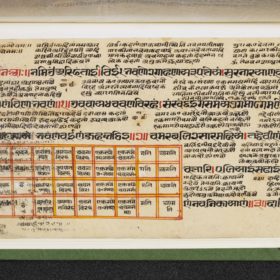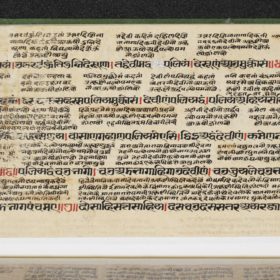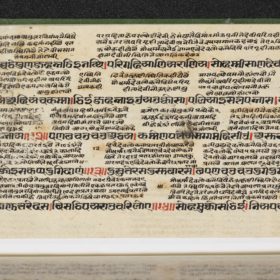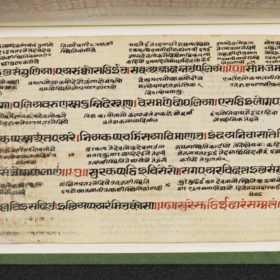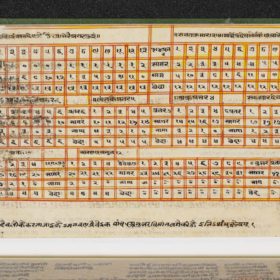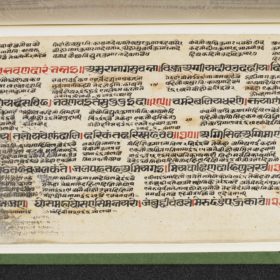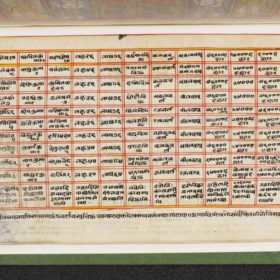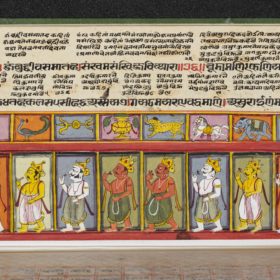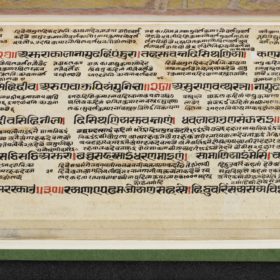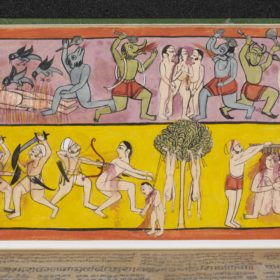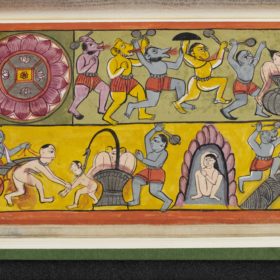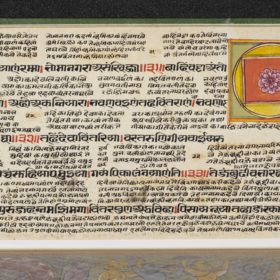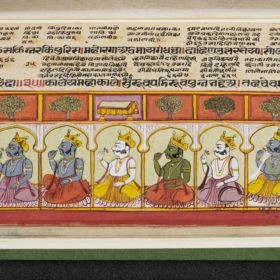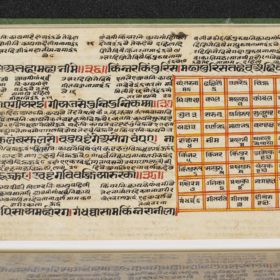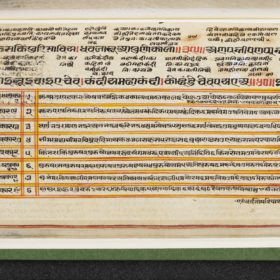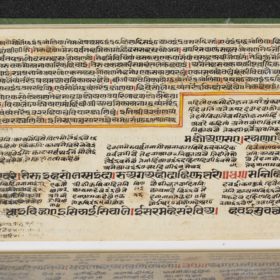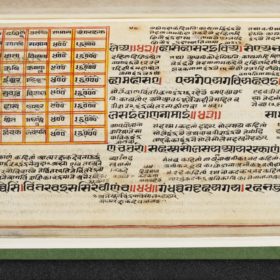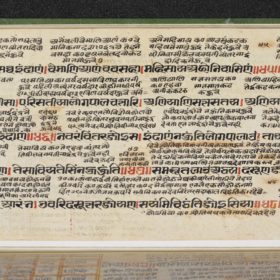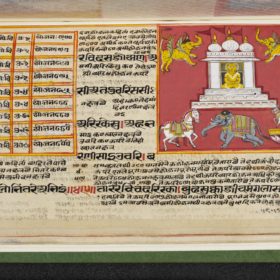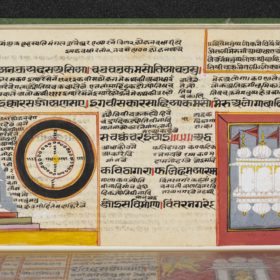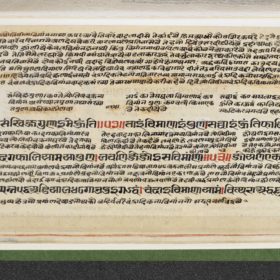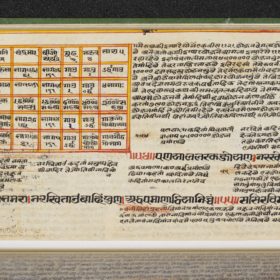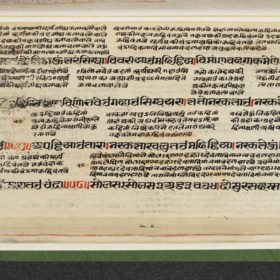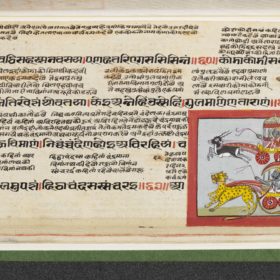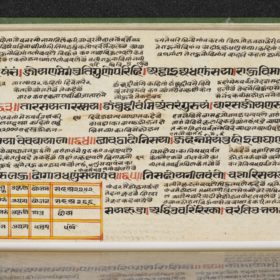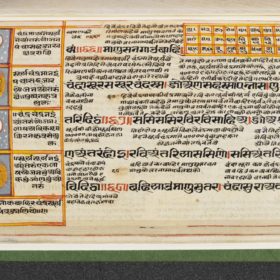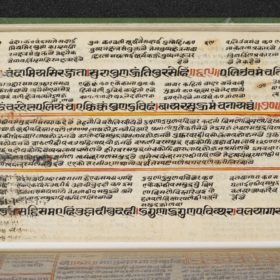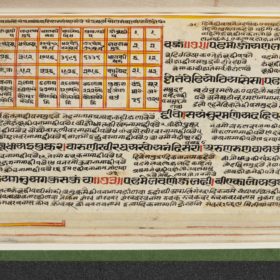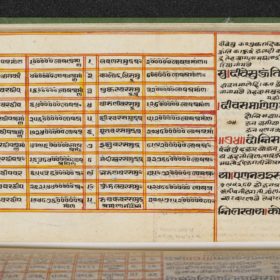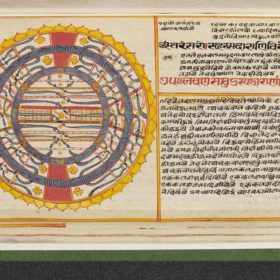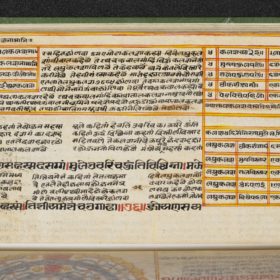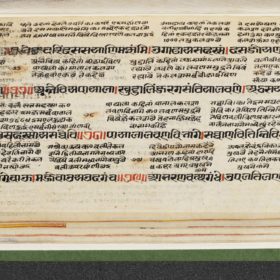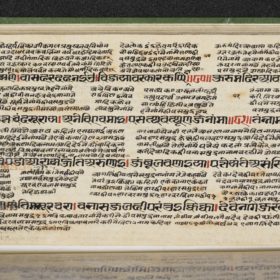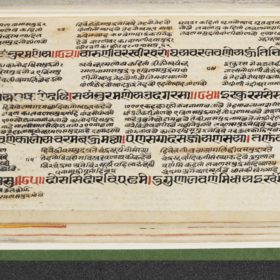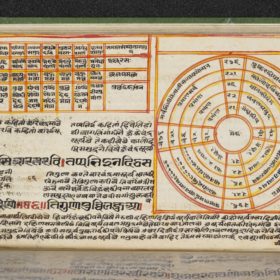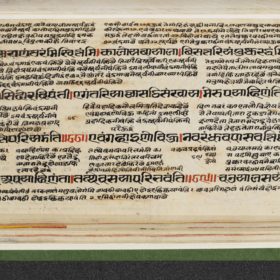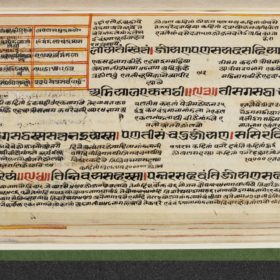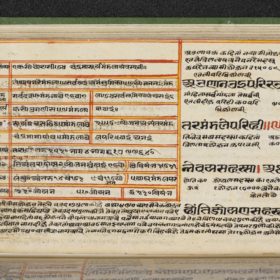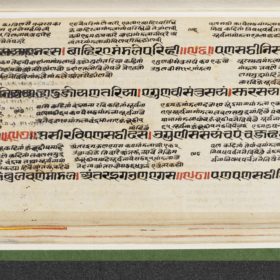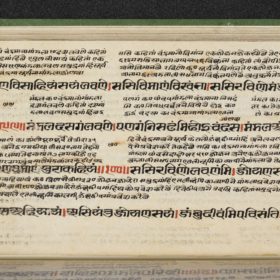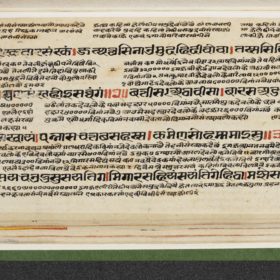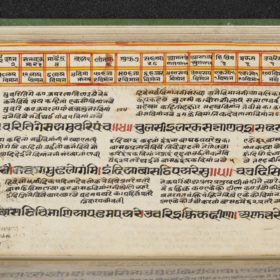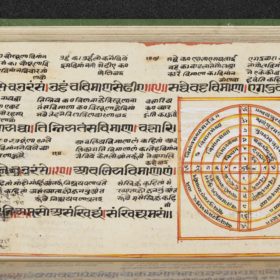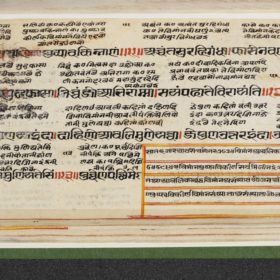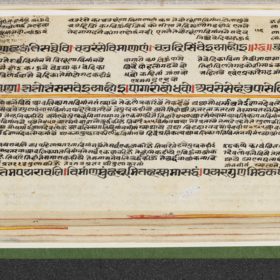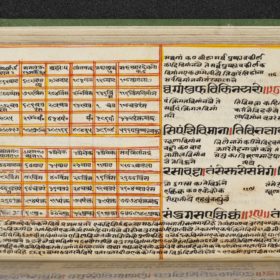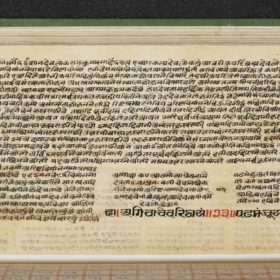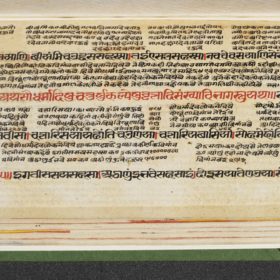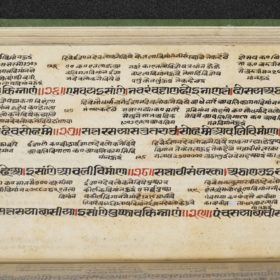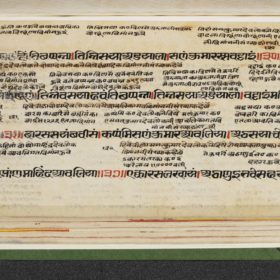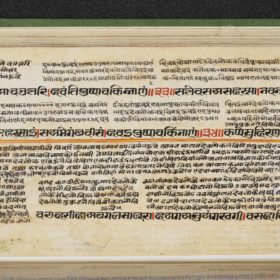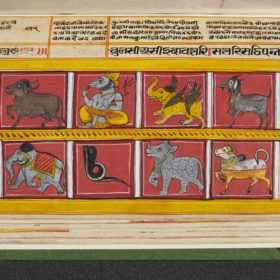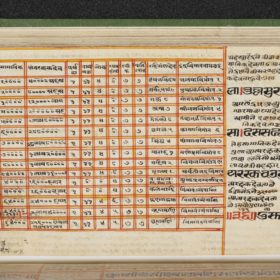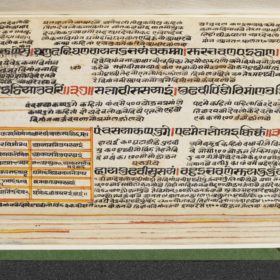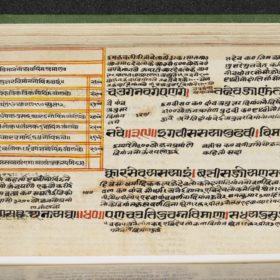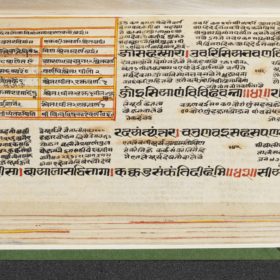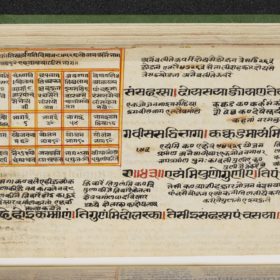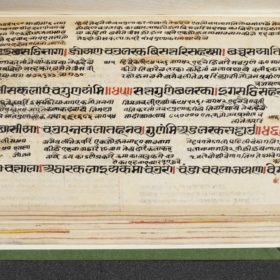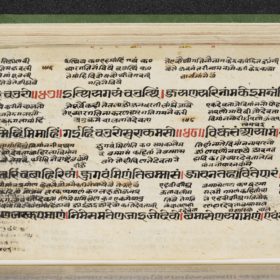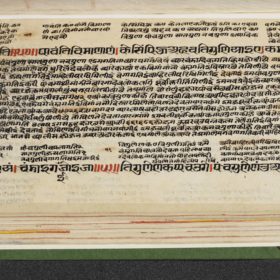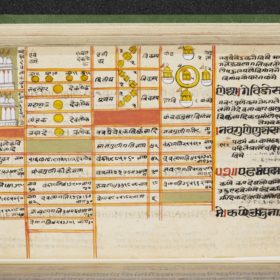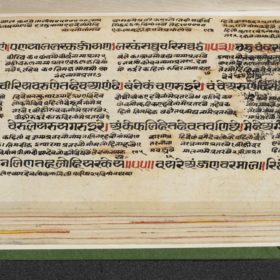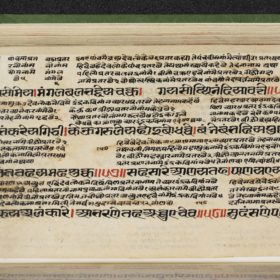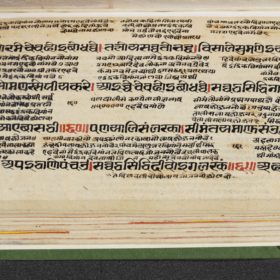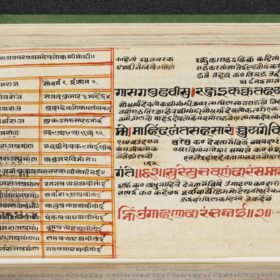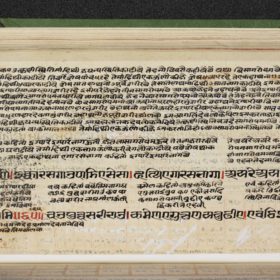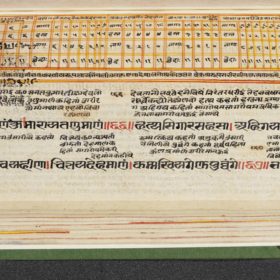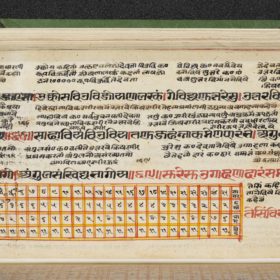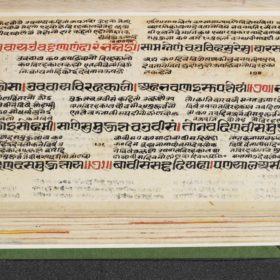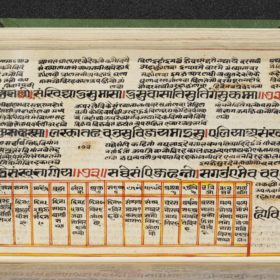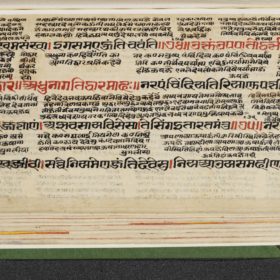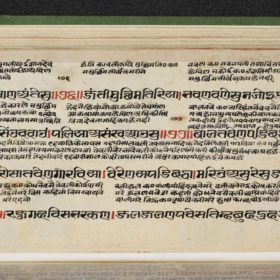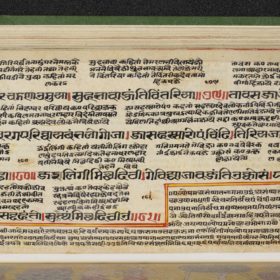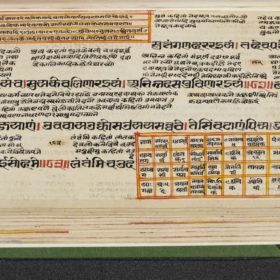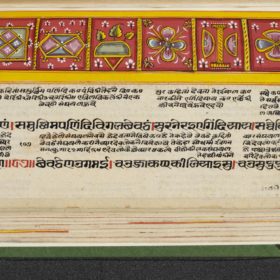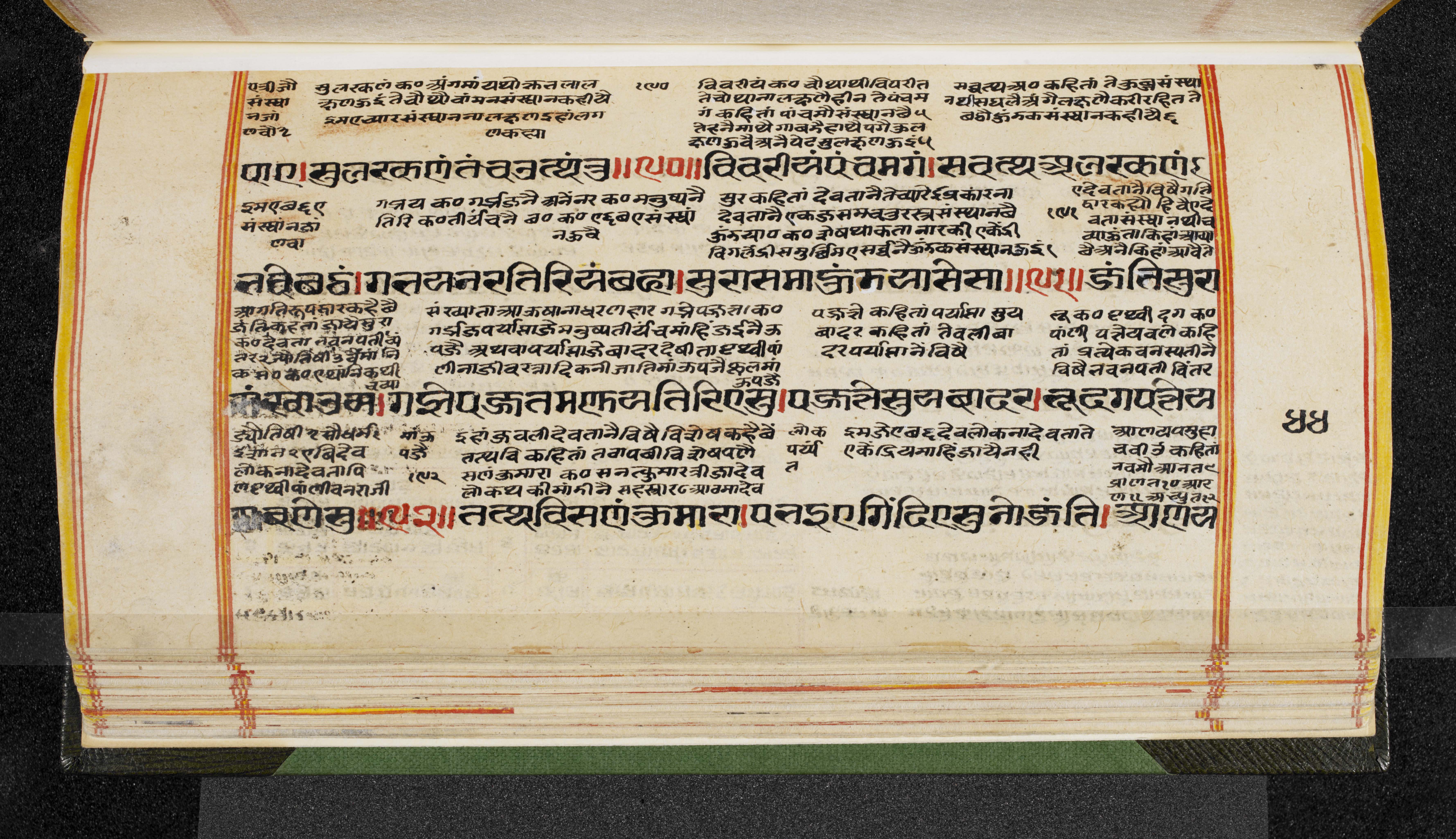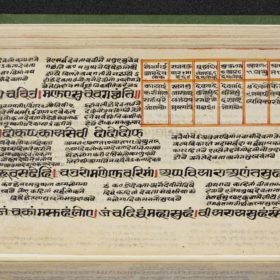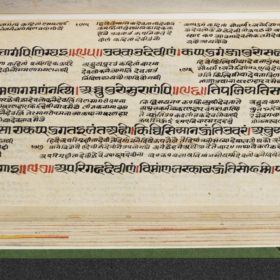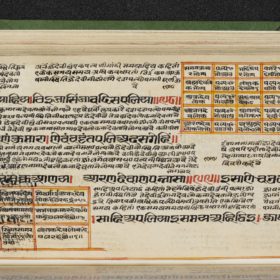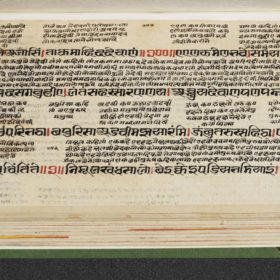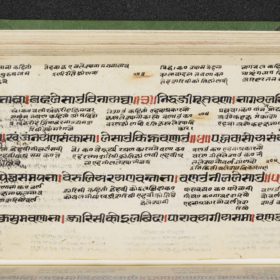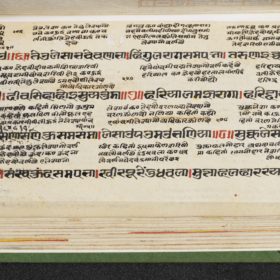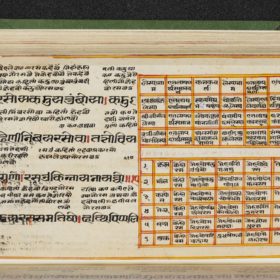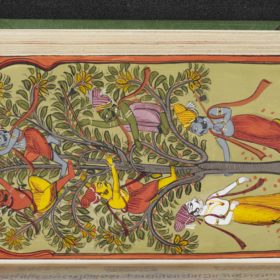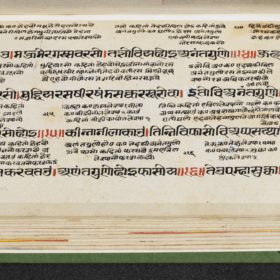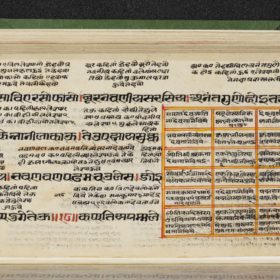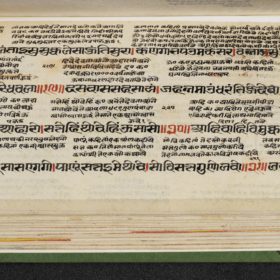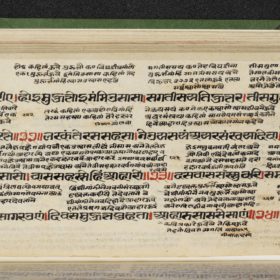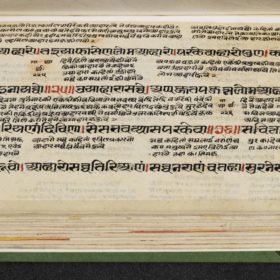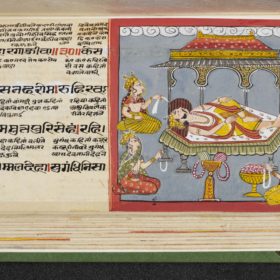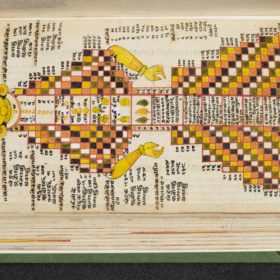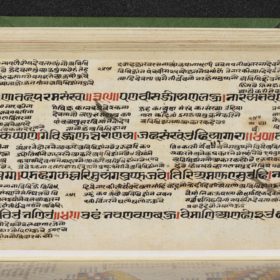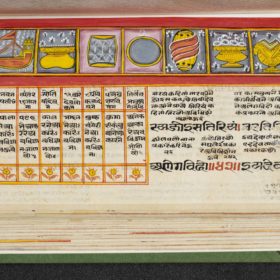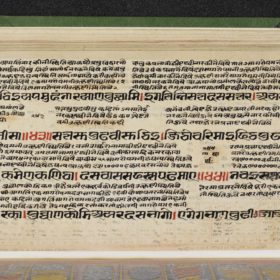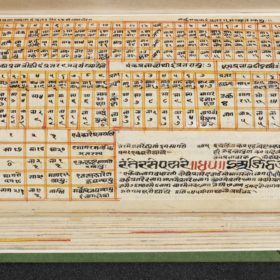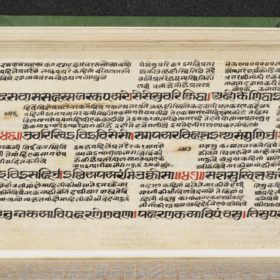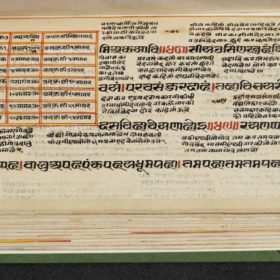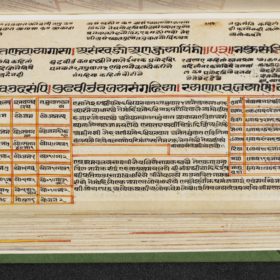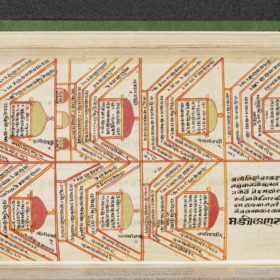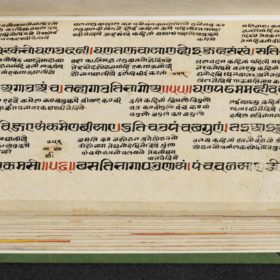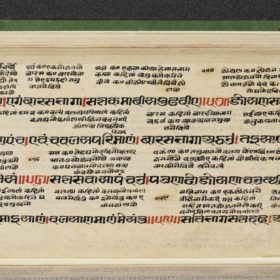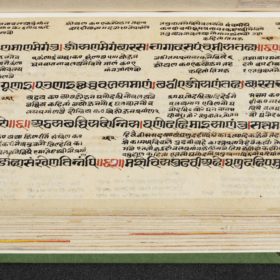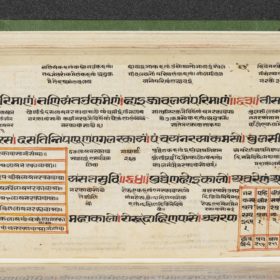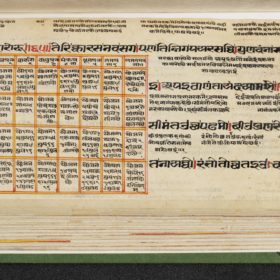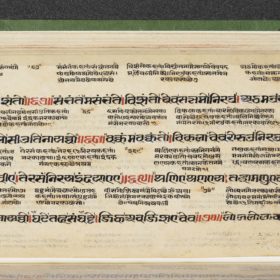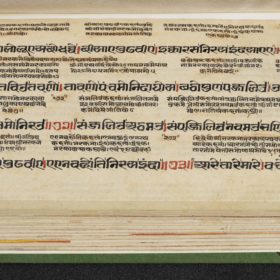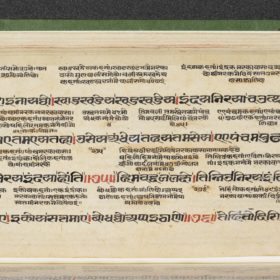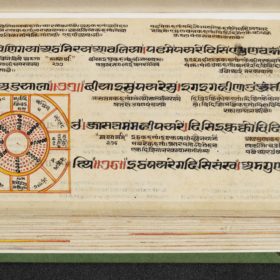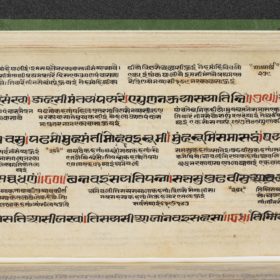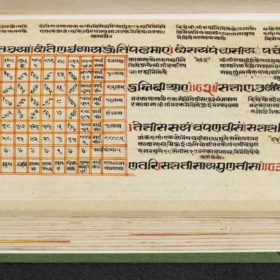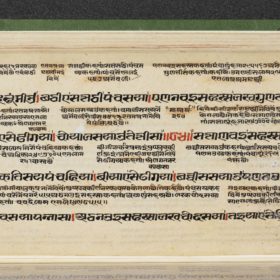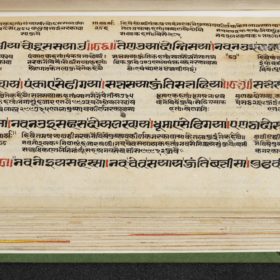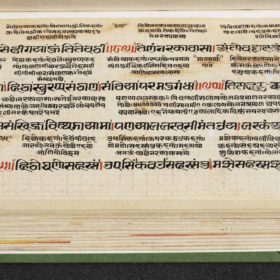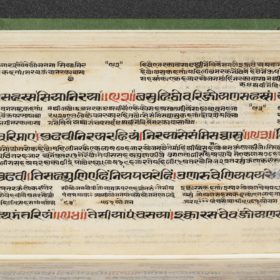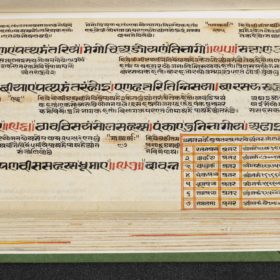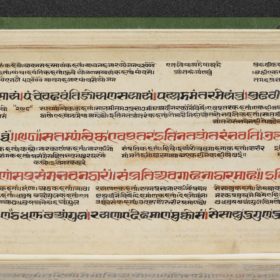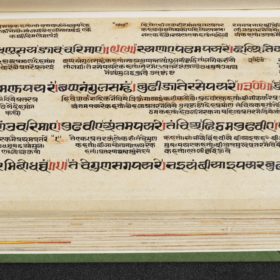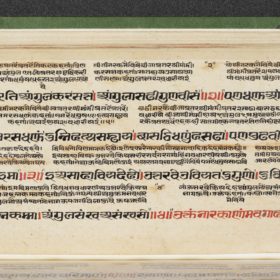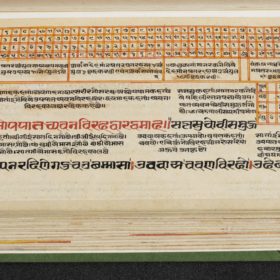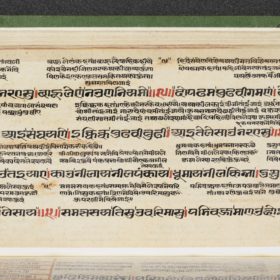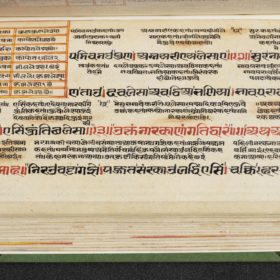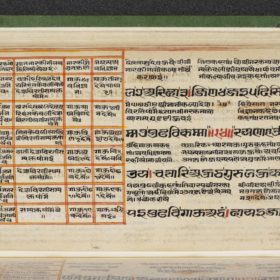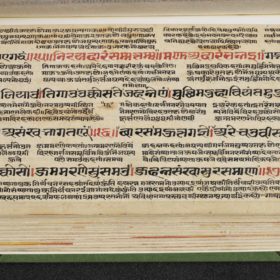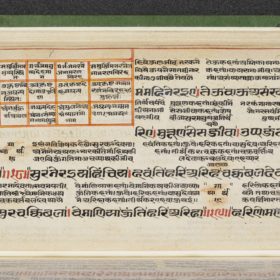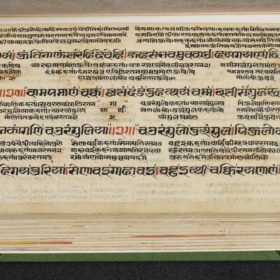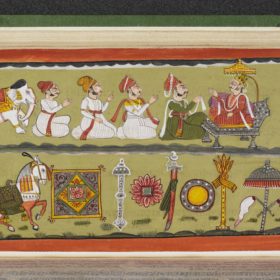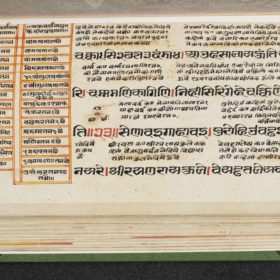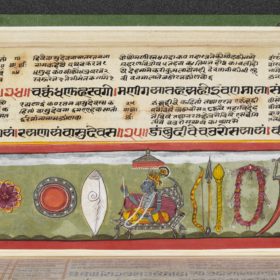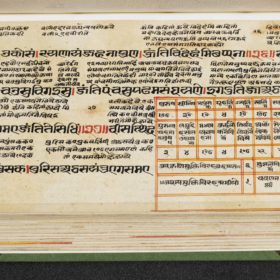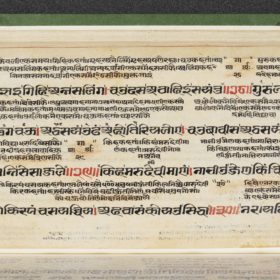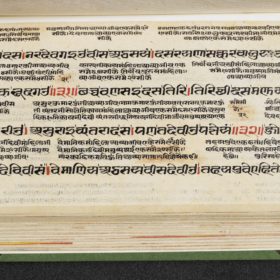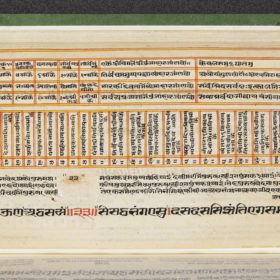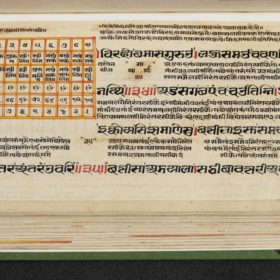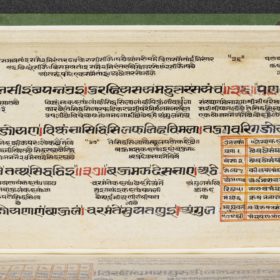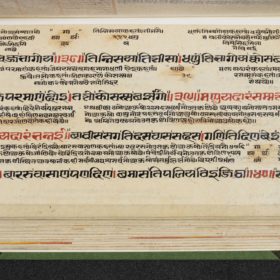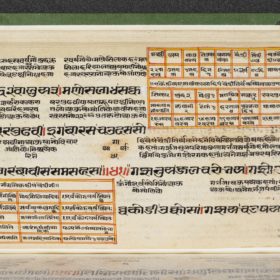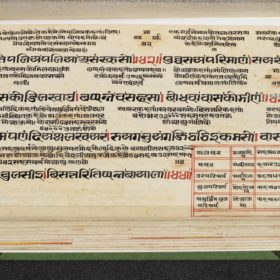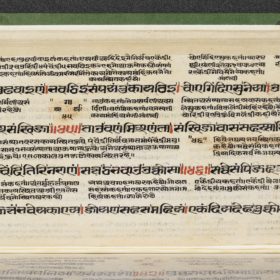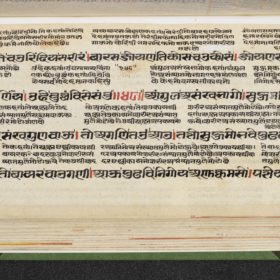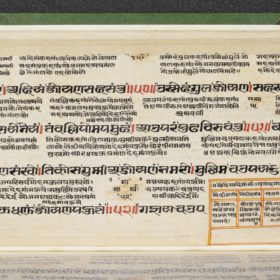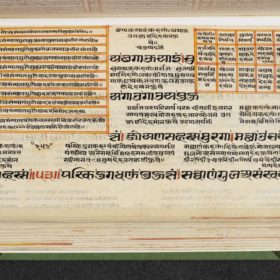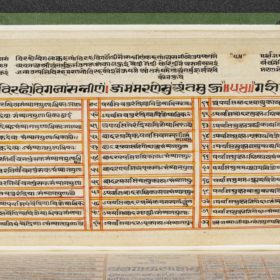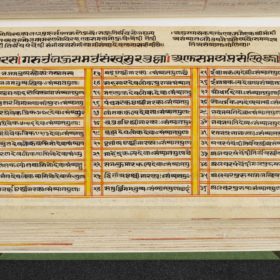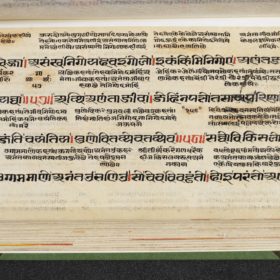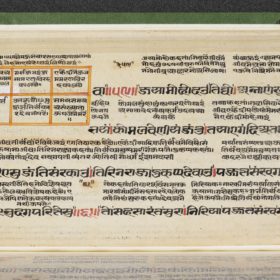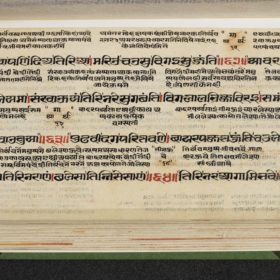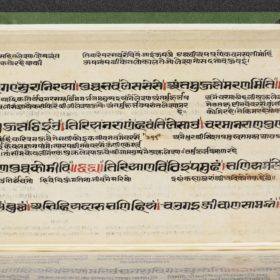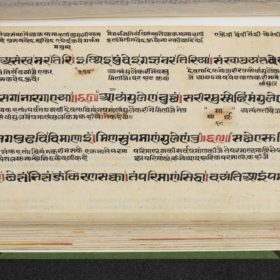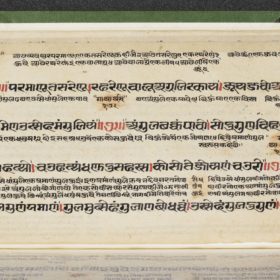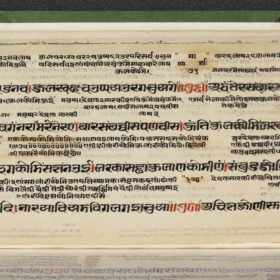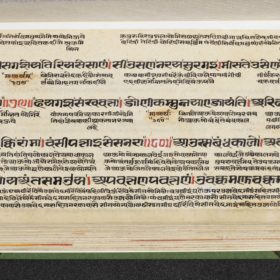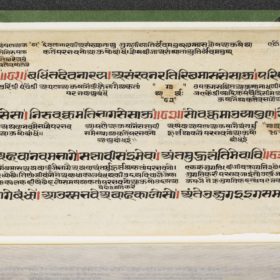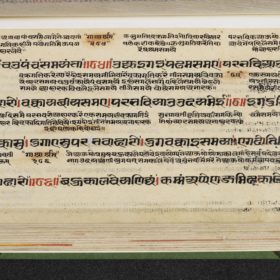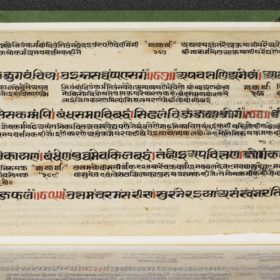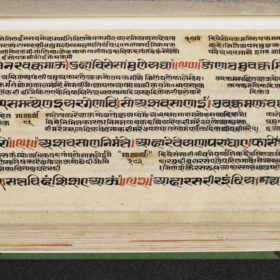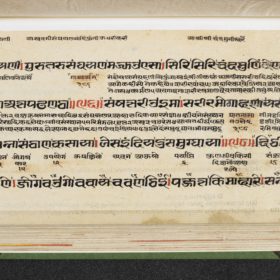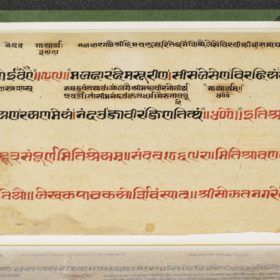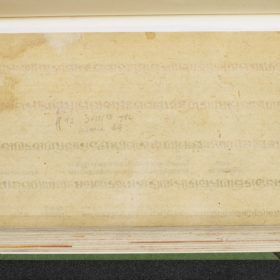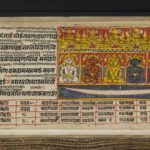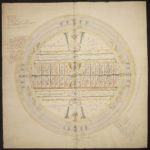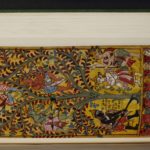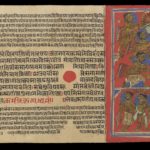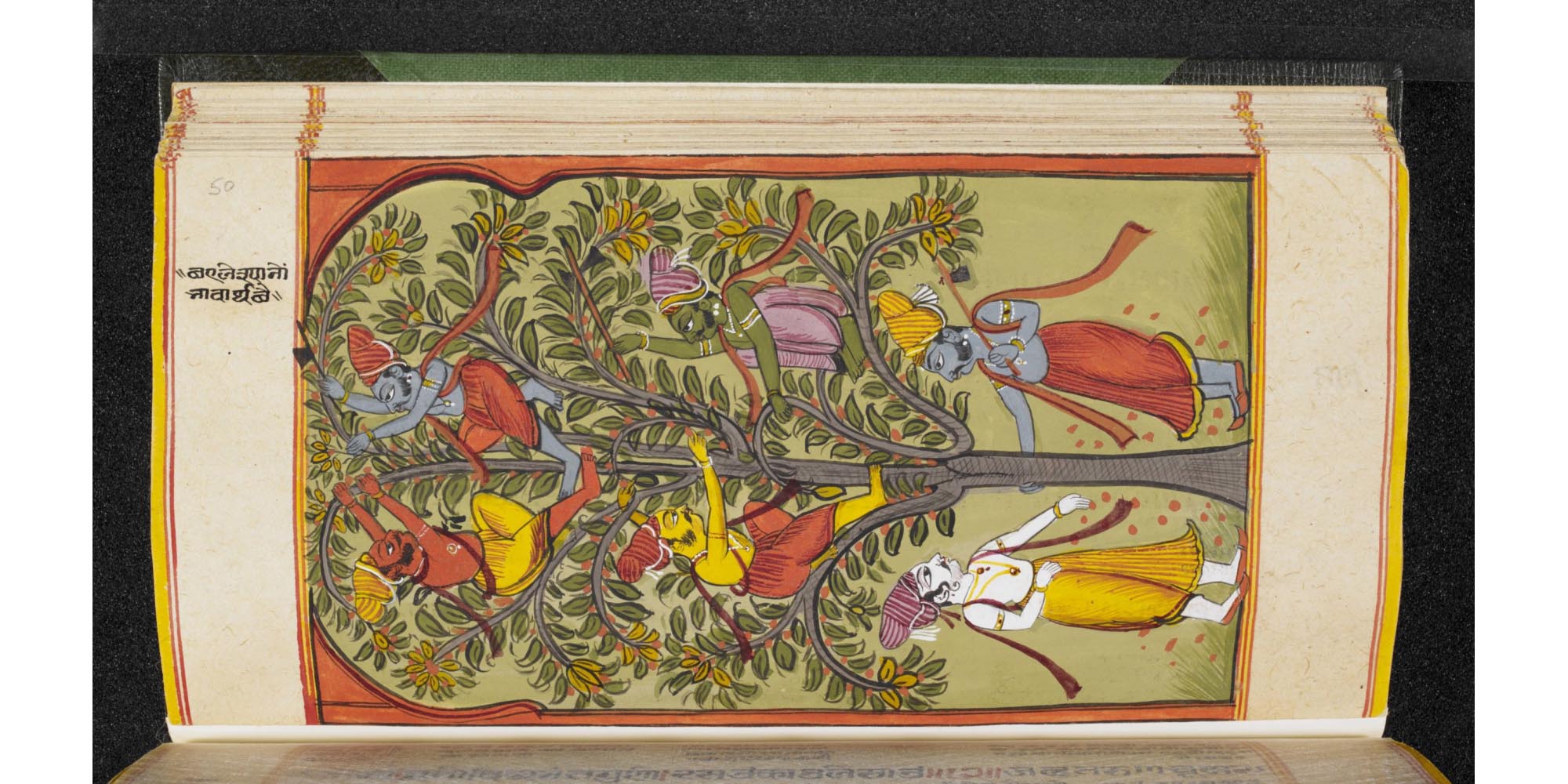
Background
The Saṃgrahaṇī-ratna belongs to the tradition of Śvetāmbara writings on the Jain universe. The monk Śrīcandra wrote Prakrit verses in the 12th century consolidating previous writings on cosmology. It is called Jewel of Summarised Verses, a phrase which underlines the condensed nature of the work.
Though Saṃgrahaṇī works describe the universe, they are mainly concerned with the beings who live in different parts of the Jain world. They go into detail about their life-duration, karma and spiritual progress much more than the geography.
Cosmological writings have generated numerous commentaries in Sanskrit or the vernacular languages. Teaching and learning cosmology remain an important part of monastic education. A rich pictorial tradition has also grown up round the Saṃgrahaṇī works, as visualisation is part of the transmission of knowledge on the Jain universe and is helpful as a means of understanding.
Jain cosmology is complex. Human beings live in the Middle World, which is the smallest of the three worlds that make up world space – loka-ākāśa. In world space all the souls live in the different body-forms they take according to their rebirths, in the various worlds. Outside world space is the non‑world space – aloka-ākāśa – which is endless. However, the Middle World is the most important area from the spiritual point of view because it is the only part where human beings can live.
Jains cannot advance spiritually without understanding and meditating upon cosmological theories so understanding them is crucial. Certain key religious concepts run through these theories. These include the notion of a physical soul shedding karma by moving through the cycle of rebirth to eventual omniscience and liberation, along with the cyclical nature of time, the interconnectedness of the universe, and the importance of symmetry, repetition and balance.
Glossary
Description
In the left margin a caption in Gujarati says: cha e leśyā no bhāvārtha chai – ‘this is the substance of the six colours of the soul’.
Six men, whose bodies are of different colours, are shown performing various actions in or around a tree. This picture has to be read in a certain order to be understood properly. Starting from the bottom right, the viewer’s gaze should move anti-clockwise.
At the bottom right, a blue-bodied man resting an axe on his shoulder holds the trunk of the tree.
Above him is a green-bodied man who has climbed the tree. He holds one branch with one hand, probably to avoid falling, and carries an axe in the other. The axe is directed towards the boughs of the tree.
Above him a blue-bodied man holds an axe, ready to cut the small branches of the tree.
Facing him is a brown-bodied man, holding firmly to the branches. He carries no tool.
Below him a yellow-bodied man has no tool, but seems ready to pluck the fruit.
At the bottom left, a white-bodied man does not carry any tool. He gestures towards the ground, indicating fruit that are windfalls or are falling down.
The tree is depicted with care for detail, with the branches, bunches of fruit and leaves shown precisely. The falling fruit are seen clearly as well. The men wear turbans and ornaments and have moustaches or beards. The way they are depicted may suggest that they are tribal people.
Illustrating a parable
This is a standard depiction of the parable of the tree, meant to illustrate the six colours of the soul – leśyā. Souls take on a different colour depending on one’s behaviour. This is a complex Jain concept narrowly connected to the doctrine of karma. This parable and illustration are the most common way of visualising the concept. The different attitudes one can have when facing an identical situation demonstrate the Soulsoul’s colour. In this parable, the six men are said to be in a jungle, thirsty and hungry, when they come across the fruit-laden jambū tree. They do different things to get the tree’s fruit.
The gradation in colour, from the darkest to the lightest, corresponds to the degree of violence or impurity in behaviour.
|
Action |
Colour of leśyā |
|---|---|
|
Cutting the tree down at the root |
black |
|
Cutting down the boughs |
blue or green, like here – nīla corresponds to both |
|
Cutting off the branches |
grey – though here it is blue |
|
Cutting off bunches of fruit |
fiery – red or yellow, though here brown |
|
Plucking the fruit from the tree |
lotus colour – here interpreted as light pink |
|
Picking up the fruit that has fallen on the ground |
white |
The leśyās are divided into two groups of three. The first group contains the extremely negative ones, the second group the less negative ones. There are variations in the way the painter renders the adjectives naming the colour. But all negative colours are on the same side as black, the others are on the same side as white. This is an organising principle of the painting.
The paintings do not always make it clear which parts of the tree that men numbers two to four intend to cut. It is often difficult to know whether the boughs, the branches or the bunches of fruit are meant.
Here, the six leśyās are depicted by the six men in the parable of the tree.
The text copied on this manuscript discusses the colours of the souls of the four classes of gods, implying several technical details. It is found in verse 217 and the following verse, found on folio 50 recto. The names of the colours occur in this verse and provide a starting point for a standard representation of this striking concept as a whole. This is the case with all manuscripts of the Saṃgrahaṇī-ratna.
Like this one, paintings representing the leśyā generally use bright colours. They often occupy a full page in a vertical orientation. The painters want to show the height of the tree and the format of the manuscript is rectangular. So the tree is not facing the reader, who opens the manuscript and sees the picture on its side, as it is here.
- Source:
The British Library Board
- Shelfmark:
Or. 13456
- Author:
Śrīcandra and Dharmameru
- Date of creation:
1812
- Folio number:
- Total number of folios:
92
- Place of creation:
Sojhata, Rajasthan
- Language:
Prākrit and Gujarati
- Medium:
paper
- Size:
28.5 x 13.5 cms
- Copyright:
CC0 1.0 (Creative Commons Public Domain)
- Image Copyright:
- +
- aAbhavya
- aAbhinandana
- aAbhiṣeka
- aĀcāra
- aĀcārāṅga-sūtra
- aĀcārya
- aAchalbhrata
- aAḍhāī-dvīpa
- aAdharma
- aAdho-loka
- aAdhyayana
- aAdvaita Vedānta
- aĀgama
- aAghātīya
- aAghātīya-karman
- aAgnibhuti
- aAgra
- aĀhāra
- aAhiṃsā
- aAhimsa Day
- aAjita
- aAjīva
- aAkampit
- aĀkāśa
- aAkbar the Great
- aAkṣaya-tṛtīyā
- aAlauddin Khalji
- aAlbert Einstein
- aAllah
- aAlms
- aĀlocanā
- aAloka-ākāśa
- aAmāri
- aAmbikā or Kūṣmāṇḍinī
- aAnagāra
- aAnanta
- aAnarthadaṇḍa
- aAnaśana
- aAnekānta-vāda
- aAṅga
- aAniconism
- aAnojjā
- aAntarāla
- aAntarāya-karma
- aAṇu
- aAṇu-vrata
- aAnukampā
- aAnuprekṣā
- aAnusvāra
- aApabhraṃśa
- aAparigraha
- aAra
- aĀrambha
- aĀrambhaja
- aĀratī
- aArdhamāgadhī Prākrit
- aArhaṃ
- aArhat
- aArśana-āvaraṇīya-karma
- aĀrta-dhyāna
- aĀryikā
- aĀryikā Jñānamati
- aĀśātanā
- aĀścarya
- aAscetic
- aAsceticism
- aAshram
- aAspiration
- aĀsrava
- aAṣṭa-maṅgala
- aAṣṭāpada
- aAstikāya
- aAstrolabe
- aAsura
- aAtheism
- aAticāra
- aAtiśayakṣetra
- aAtithisaṃvibhāgavrata
- aĀtma-vāda
- aĀtman
- aAuṃ
- aAurangzeb
- aAuspicious
- aAusterity
- aAvadhāna
- aAvadhi-jñāna
- aĀvaraṇī-yakarman
- aAvasarpiṇī
- aAvatāra
- aAvidyā
- aAxiom
- aĀyāga-paṭa
- aĀyambil
- aĀyu-karma
- aĀyurveda
- bBabur
- bBāhubali
- bBaladeva
- bBālāvabodha
- bBandha
- bBasadi
- bBazaar
- bBhadrankarvijay
- bBhagavant
- bBhaktāmara-stotra
- bBhakti
- bBhale
- bBharata
- bBhāṣā
- bBhāṣya
- bBhaṭṭāraka
- bBhāva
- bBhāva-pūjā
- bBhāvanā
- bBhavana-vāsin
- bBhavya
- bBhavyatva
- bBhaya
- bBhoga-bhūmi
- bBhogopabhoga
- bBodhi
- bBollywood
- bBrahmā
- bBrahma-deva
- bBrahmacārī
- bBrāhmaṇa
- bBraj Bhāṣā
- bBright fortnight
- bBritish Raj
- bBuddha
- bBuddhi-sagar
- bBuddhism
- bBuddhist
- cCaitya
- cCaityavāsin
- cCakravartin
- cCakreśvarī
- cCāmara
- cCandanā
- cCandragupta
- cCandraprabha
- cCanon
- cCāritra
- cCāritramohanīya-karman
- cCarũrī
- cCaste
- cCaturvidha-saṅgha
- cCaturviṃśati-stava
- cCāturyāma
- cCE
- cCelibacy
- cCha
- cChadmastha
- cChastity
- cCheda-sūtra
- cChristian
- cChristianity
- cClergy
- cCloning
- cColophon
- cCommentary
- cConch
- cConfession
- cCongregation
- cConsecration
- cCosmology
- cCremation
- cCrore
- cCult
- cCūrṇi
- dDādā-guru
- dDalit
- dDāna
- dDaṇḍa
- dDark fortnight
- dDarśana
- dDarśanamohanī-yakarman
- dDaśa-lakṣaṇa-parvan
- dDeity
- dDelhi Sultanate
- dDerāsar
- dDeśāvakāśika-vrata
- dDetachment
- dDevanāgarī
- dDevānandā
- dDevarddhi-gani
- dDevotee
- dDhamal
- dDhanuṣ
- dDhāra
- dDharma
- dDharma-dhyāna
- dDharma-sāgara
- dDharmastikaya
- dDhātakīkhaṇḍa
- dDholak
- dDhyāna
- dDiaspora
- dDig-vrata
- dDigambara
- dDīkṣā
- dDisciple
- dDīvālī
- dDivya-dhvani
- dDNA
- dDoctrine
- dDogma
- dDonor
- dDoṣa
- dDravya
- dDravya-pūjā
- dDrone
- dDuṣamā
- dDuṣamā-duṣamā
- dDuṣamā-suṣamā
- dDveṣa
- dDvīpa
- eEast India Company
- eEightfold Path
- eEkānta-vāda
- eEkendriya
- eElder
- eElders
- eEschatology
- eEtc up to
- fFarmān
- fFast
- fFatehpur Sikri
- fFestival
- fFestschrift
- fFiruz Shah
- fFly-Whisks
- fFolio
- fFour Noble Truths
- gGaccha
- gGaṇa
- gGaṇadhara
- gGanadharavada
- gGaṇeśa
- gGaṇin
- gGarba
- gGarbha
- gGarbha-gṛha
- gGaruḍa
- gGati
- gGene
- gGenomics
- gGhātī-yakarman
- gGhātīya
- gGhaznavid
- gGhiyasuddin Tughlaq
- gGhurid
- gGloss
- gGotra-karma
- gGujarāt
- gGujarati
- gGuṇa
- gGuṇa-sthāna
- gGuṇa-vrata
- gGupti
- gGuru
- gGuruṇī
- hHagiography
- hHajj
- hHaṃsa
- hHaribhadra
- hHariṇaigameṣin
- hHasta
- hHeresy
- hHiṃsā
- hHindi
- hHindu
- hHinduism
- hHīravijaya
- hHoroscope
- hHrīṃ
- hHumayun
- hHymn
- iIconoclasm
- iIconography
- iIdol
- iIndian Independence
- iIndology
- iIndra
- iIndrabhūti Gautama
- iIndriya
- iInitiation
- iIntercession
- iInvocation
- iIQ
- iIslam
- iIslamicate
- iIṣṭadevatā
- iĪśvara
- jJagat
- jJahangir
- jJain
- jJaina Devanāgarī
- jJaina Śaurasenī
- jJaina-dharma
- jJainaśāsana
- jJainness
- jJaisalmer
- jJamāli
- jJambū-dvīpa
- jJames Burgess
- jJanma
- jJanma-kalyāṇa
- jJarā
- jJāti
- jJina
- jJina-āgama
- jJina-bhavana
- jJina-bimba
- jJina-mātā
- jJinacandra-sūri
- jJinadatta
- jJinaprabha
- jJīva
- jJñāna
- jJñāna-āvaraṇīya-karma
- jJñāna-āvarṇiya
- jJñānsundar
- jJyotiṣka
- kKāla
- kKālakācārya-kathā
- kKālidāsa
- kKalpa-sūtra
- kKalpa-vṛkṣa
- kKalyāṇaka
- kKalyanvijay
- kKamaṇḍalu
- kKamaṭha
- kKarma
- kKarma-bhūmi
- kKarma-grantha
- kKarma-prakṛti
- kKarma-vāda
- kKarmon
- kKarnataka
- kKaṣāya
- kKathā
- kKāvya
- kKāya
- kKāyotsarga
- kKeśa-loca
- kKetu
- kKevala-jñāna
- kKevalin
- kKhalji
- kKharatara-gaccha
- kKnowledge
- kKriyā
- kKriyā-vāda
- kKṛṣṇa
- kKṣamā-śramaṇa
- kKṣapakaśreṇi
- kKṣatriya
- kKṣullaka
- kKulakara
- kKundakunda
- kKunthu
- lLabdhi
- lLaity
- lLakh
- lLāñchana
- lLands of Action
- lLaukāntika
- lLavaṇa-samudra
- lLeśyā
- lLiṅga
- lLinguistics
- lLoka
- lLoka-ākāśa
- lLoka-puruṣa
- lLoka-vāda
- lLotus
- lLotus lake
- mMadhya-loka
- mMahā-videha
- mMahā-vrata
- mMahābhārata
- mMahāmastakābhiṣeka
- mMāhārāṣṭra
- mMāhārāṣṭrī Prākrit
- mMahattarā Yākinī
- mMahāvīr Jayantī
- mMahāvīra
- mMakāra
- mMakkhali Gośāla
- mMalli
- mMāna-stambha
- mManaḥ-paryāya-jñāna
- mMaṇḍala
- mMaṇḍapa
- mMandit
- mMaṅgala
- mMantra
- mMantras
- mManuṣya-loka
- mMarāṭhī
- mMārgaṇā
- mMartyr
- mMarudevī
- mMaṭha
- mMati-jñāna
- mMauryaputra
- mMecca
- mMendicant lineage
- mMetarya
- mMiracle
- mMithyādṛṣṭi
- mMohandas Gandhi
- mMohanīya-karma
- mMokṣa
- mMonastic order
- mMonasticism
- mMonk
- mMonotheism
- mMosque
- mMount Meru
- mMount Sammeta
- mMṛgāvatī
- mMughal
- mMuhammad
- mMuhammad bin Tughlaq
- mMuhpattī
- mMūla-sūtra
- mMūlaguṇa
- mMumbaī
- mMuni
- mMunisuvrata
- mMurad Bakhsh
- mMūrti-pūjaka
- mMuslim
- mMysticism
- nNābhi
- nNāga-kal
- nNāgapurīya Tapā-gaccha
- nNāgarī
- nNāma-karma
- nNamaskāra-mantra
- nNami
- nNandīśvara-dvīpa
- nNandivardhana
- nNandyāvarta
- nNāraka
- nNāraki
- nNasalisation
- nNātha
- nNavrātrī
- nNaya-vāda
- nNemi
- nNidāna
- nniggaṃthāṇa vā 2
- nniggaṃtho vā 2
- nNigoda
- nNihnava
- nNikṣepa
- nNirgrantha
- nNirjarā
- nNirvāṇa
- nNiryukti
- nNiṣidhi
- nNitya
- nNiyati
- nNo-kaṣāya
- nNudity
- nNun
- oOcean of milk
- oOmniscience
- oOrdination
- ppa°
- pPadmaprabha
- pPadmāsana
- pPadmāvatī
- pPādukā
- pPalanquin
- pPalette
- pPañca-muṣṭi
- pPāṇḍava
- pPaṇḍit
- pPandit Dalsukh D. Malvania
- pPandit Sukhlalji
- pPāṇipātra
- pPāpa
- pParamātman
- pParameṣṭhin
- pPāraṇā
- pParigraha
- pPariṇāma
- pParīṣaha
- pParokṣa
- pPārśva
- pPārśvanātha
- pParyāya
- pParyuṣaṇ
- pPaṭa
- pPatan
- pPātra
- pPenance
- pPersian
- pPhala
- pPhilology
- pPicchikā
- pPilgrimage
- pPīr
- pPolymath
- pPoṣadha
- pPossession
- pPothī
- pPrabhas
- pPradakṣiṇā
- pPradeśa
- pPrākāra
- pPrakīrṇaka-sūtra
- pPrākrit
- pPramāda
- pPramukhā
- pPrati-vāsudeva
- pPratikramaṇa
- pPratimā
- pPratiṣṭhā
- pPratyākhyāna
- pPratyakṣa
- pPravacana
- pPrāyaścitta
- pPrayer
- pPre-modern
- pPreach
- pPredestination
- pProtestant
- pProvenance
- pPudgala
- pPūjā
- pPujārī
- pPukharavara-dvīpa
- pPuṇya
- pPūrva
- pPuṣkara-dvīpa
- pPuṣpadanta
- pPyre
- qQur’an
- rRāga
- rRāhu
- rRainy season
- rRajasthan
- rRajasthani
- rRājimatī
- rRajoharaṇa
- rRajput
- rRāma
- rRāmāyaṇa
- rRangoli
- rRās-garbā
- rRasa
- rRathanemi
- rRatna-traya
- rRātri-bhojana
- rRaudra-dhyāna
- rRecto
- rRelic
- rRenunciation
- rRetroflex
- rRevatī
- %Ṛg-veda
- rRite
- rRosary
- %Ṛṣabha
- %Ṛṣabhanātha
- rRupee
- sSaciyā Mātā
- sSādhu
- sSādhvī
- sSāgāra
- sSaint
- sŚaivaism
- sŚaka-saṃvat
- sSallekhanā
- sŚalya
- sSamacatuṣṭha
- sSamādhimaraṇa
- sSamaṇi
- sSāmarambha
- sSamavasaraṇa
- sSāmāyika
- sSaṃbhava
- sSamiti
- sSaṃjñā
- sSaṃkalpaja
- sSaṃsāra
- sSamudghāta
- sSaṃvara
- sSaṃvega
- sSamyak-cāritra
- sSamyak-darśana
- sSamyak-jñāna
- sSamyaktva
- sSaṃyama
- sSanctuary
- sSandalwood
- sSaṇgha
- sSanskrit
- sSant
- sŚānti
- sSapta-bhaṅgi-naya
- sSārambha
- sSarasvatī
- sSarvajña
- sSāsan-devi
- sŚāsana-devatā
- sŚāstra
- %Ṣaṭ-jīvanikāya
- sSatī
- sSatīmātā
- sSatya
- sSchism
- sScribe
- sScripture
- sSect
- sSecularism
- sŚenāī
- sSermon
- sŚeṣavatī
- sSevā
- sSeven fields of donation
- sShah Jahan
- sShantidas Jhaveri
- sShrine
- sSiddha
- sSiddha-śilā
- sSiddhacakra or Navadevatā
- sSiddhānta
- sSiddhārtha
- sSiddhi
- sSikh
- sSikhism
- sŚikṣā-vrata
- sŚīla
- sSin
- sSindh
- sŚītala
- sŚiva
- sSkandha
- sSomanatha
- sŚraddhā
- sŚramaṇa
- sŚrāvaka
- sŚrāvakācāra
- sŚrāvikā
- sŚreyāṃsa
- sŚrī
- sŚrīvatsa
- sŚruta-jñāna
- sŚruta-pañcamī
- sSthānaka-vāsin
- sSthāpanācārya
- sSthāvara
- sSthavira
- sSthiti
- sStrīmukti
- sStūpa
- sSubcontinent
- sSudarshana
- sŚuddhi
- sSudharma
- sŚūdra
- sSufism
- sSukha
- sŚukla-dhyāna
- sSulasā
- sSultan
- sSumati
- sSundarśrī
- sSupārśva
- sSūri
- sSuṣamā
- sSuṣamā-duṣamā
- sSuṣamā-suṣamā
- sSūtra
- sSuyam me ausam! Tenam bhagavaya evamakkhayam
- sSvādhyāya
- sSvāhā
- sSvastika
- sŚvetāmbara
- sŚvetāmbara Terāpanthin
- sŚvetāmbaras
- sSwan
- sSyād-vāda
- tTabla
- tTantra
- tTapā-gaccha
- tTapas
- tTāraṇ Svāmī Panth
- tTattva
- tTattvārtha-sūtra
- tTemple
- tTemple-city
- tThe Enlightenment
- tTheology
- tThree worlds
- %Ṭīkā
- tTilaka
- tTīrtha
- tTīrthaṃkaranāma-karman
- tTīrthankara
- tTransliteration
- tTrasa
- tTrasa-nāḍī
- tTriśalā
- tTriṣaṣṭi-śalākā-puruṣa-caritra
- tTti bemi
- tTughlaq
- tTunk
- uUdumbara
- uUniversal History
- uUpādhyāya
- uUpāṅga
- uUpaniṣads
- uUpāsaka
- uUpasarga
- uUpāśraya
- uŪrdhva-loka
- uUtsarpiṇī
- uUttarādhyayana-sūtra
- vVāhana
- vVaimānika
- vVairāgya
- vVaiṣṇava
- vVaiśramaṇa
- vVaiśya
- vValabhī
- vVanaspatikāya
- vVandana
- vVaṇik
- vVarṇa
- vVāsudeva
- vVāsupūjya
- vVayubhūti
- vVeda
- vVedanīya-karma
- vVegetarianism
- vVehicle
- vVernacular
- vVerso
- vVidyā
- vVidyā-devī
- vVihāra
- vVijñapti-patra
- vVikrama-saṃvat
- vVikṛti
- vVimala
- vVinaya
- vVipāka
- vVirji Vora
- vVirodhaja
- vVīrya
- vVisarga
- vViṣṇu
- vVītarāga
- vVizier
- vVotive
- vVow
- vVrata
- vVS
- vVyakta
- vVyantara
- vVyasana
- yYakṣa
- yYakṣī
- yYantra
- yYaśoda
- yYaśovijaya
- yYati
- yYātrā
- yYoga
- yYoginī
- yYojana
Description
In the left margin a caption in Gujarati says: cha e leśyā no bhāvārtha chai – ‘this is the substance of the six colours of the soul’.
Six men, whose bodies are of different colours, are shown performing various actions in or around a tree. This picture has to be read in a certain order to be understood properly. Starting from the bottom right, the viewer’s gaze should move anti-clockwise.
At the bottom right, a blue-bodied man resting an axe on his shoulder holds the trunk of the tree.
Above him is a green-bodied man who has climbed the tree. He holds one branch with one hand, probably to avoid falling, and carries an axe in the other. The axe is directed towards the boughs of the tree.
Above him a blue-bodied man holds an axe, ready to cut the small branches of the tree.
Facing him is a brown-bodied man, holding firmly to the branches. He carries no tool.
Below him a yellow-bodied man has no tool, but seems ready to pluck the fruit.
At the bottom left, a white-bodied man does not carry any tool. He gestures towards the ground, indicating fruit that are windfalls or are falling down.
The tree is depicted with care for detail, with the branches, bunches of fruit and leaves shown precisely. The falling fruit are seen clearly as well. The men wear turbans and ornaments and have moustaches or beards. The way they are depicted may suggest that they are tribal people.
Illustrating a parable
This is a standard depiction of the parable of the tree, meant to illustrate the six colours of the soul – leśyā. Souls take on a different colour depending on one’s behaviour. This is a complex Jain concept narrowly connected to the doctrine of karma. This parable and illustration are the most common way of visualising the concept. The different attitudes one can have when facing an identical situation demonstrate the Soulsoul’s colour. In this parable, the six men are said to be in a jungle, thirsty and hungry, when they come across the fruit-laden jambū tree. They do different things to get the tree’s fruit.
The gradation in colour, from the darkest to the lightest, corresponds to the degree of violence or impurity in behaviour.
|
Action |
Colour of leśyā |
|---|---|
|
Cutting the tree down at the root |
black |
|
Cutting down the boughs |
blue or green, like here – nīla corresponds to both |
|
Cutting off the branches |
grey – though here it is blue |
|
Cutting off bunches of fruit |
fiery – red or yellow, though here brown |
|
Plucking the fruit from the tree |
lotus colour – here interpreted as light pink |
|
Picking up the fruit that has fallen on the ground |
white |
The leśyās are divided into two groups of three. The first group contains the extremely negative ones, the second group the less negative ones. There are variations in the way the painter renders the adjectives naming the colour. But all negative colours are on the same side as black, the others are on the same side as white. This is an organising principle of the painting.
The paintings do not always make it clear which parts of the tree that men numbers two to four intend to cut. It is often difficult to know whether the boughs, the branches or the bunches of fruit are meant.
Here, the six leśyās are depicted by the six men in the parable of the tree.
The text copied on this manuscript discusses the colours of the souls of the four classes of gods, implying several technical details. It is found in verse 217 and the following verse, found on folio 50 recto. The names of the colours occur in this verse and provide a starting point for a standard representation of this striking concept as a whole. This is the case with all manuscripts of the Saṃgrahaṇī-ratna.
Like this one, paintings representing the leśyā generally use bright colours. They often occupy a full page in a vertical orientation. The painters want to show the height of the tree and the format of the manuscript is rectangular. So the tree is not facing the reader, who opens the manuscript and sees the picture on its side, as it is here.





























































































